Strain Rate and Temperature Effects on Formability and Microstructure of AZ31B Magnesium Alloy Sheet
Abstract
:1. Introduction
2. Materials and Methods
2.1. Material and Sample Design
2.2. Experimental Methods
3. Results and Discussion
3.1. Mechanical Property
3.2. Microstructure Evolution
4. Conclusions
- (1)
- AZ31B magnesium alloy sheets behave positively to temperature sensitivity when forming at a temperature lower than 200 °C.
- (2)
- The partially recrystallized AZ31B was exhibited at a temperature of 150 °C, and the approximate complete recrystallization was exhibited at a temperature of 250 °C. At room temperature, the quasi-cleavage fracture pattern is the main fracture pattern for AZ31B in the forming process. However, with an increasing temperature, the fracture pattern of AZ31B transits from a quasi-cleavage fracture pattern to a ductile fracture pattern in the forming process. At a high temperature, the ductile fracture pattern is the main fracture pattern for AZ31B in the forming process.
- (3)
- The strain rate is an important factor in affecting the plasticity and formability of AZ31B. At room temperature, there is no obvious effect. However, with the increasing temperature, the distinct effect of the strain rate on the grain structure and plasticity is exhibited at a temperature of 150 °C, and a more serious effect is exhibited at a temperature of 250 °C.
- (4)
- The percentage elongation after the fracture of AZ31B declined with the increasing strain rates. The formability and plasticity would be improved by controlling the lower strain rate and the higher temperature in the forming process.
Author Contributions
Funding
Institutional Review Board Statement
Informed Consent Statement
Data Availability Statement
Acknowledgments
Conflicts of Interest
References
- Shen, Y.; Song, Y.; Hua, L.; Lu, J. Influence of plastic deformation on martensitic transformation during hot stamping of complex structure auto parts. J. Mater. Eng. Perform. 2017, 26, 1830–1838. [Google Scholar] [CrossRef]
- Wang, W.; Chen, S.; Tao, K.; Gao, K.; Wei, X. Experimental investigation of limit drawing ratio for AZ31B magnesium alloy sheet in warm stamping. Int. J. Adv. Manuf. Technol. 2017, 92, 723–731. [Google Scholar] [CrossRef]
- Song, J.; She, J.; Chen, D.; Pan, F. Latest research advances on magnesium and magnesium alloys worldwide. J. Magnes. Alloy. 2020, 5, 1–41. [Google Scholar] [CrossRef]
- Wang, S.; Gao, G. Performance of extruded magnesium alloy AZ31B circular tubes under uniaxial compression. Thin-Walled Struct. 2018, 131, 464–474. [Google Scholar] [CrossRef]
- Yang, Q.; Jiang, B.; Song, B.; Yu, Z.; He, D.; Chai, Y.; Zhang, J.; Pan, F. The effects of orientation control via tension-compression on microstructural evolution and mechanical behavior of AZ31 Mg alloy sheet. J. Magnes. Alloy. 2022, 10, 411–422. [Google Scholar] [CrossRef]
- Jabbari, A.H.; Sedighi, M.; Sabet, A.S. Combination of Mechanical and Electromagnetic Stirring to Distribute Nano-Sized Al2O3 Particles in Magnesium Matrix Composite. Powder Metall. Met. Ceram. 2019, 58, 361–371. [Google Scholar] [CrossRef]
- Jia, W.; Ma, L.; Le, Q.; Zhi, C.; Liu, P. Deformation and fracture behaviors of AZ31B Mg alloy at elevated temperature under uniaxial compression. J. Alloy. Compd. 2019, 783, 863–876. [Google Scholar] [CrossRef]
- Chai, Y.; Song, Y.; Jiang, B.; Fu, J.; Jiang, Z.; Yang, Q.; Sheng, H.; Huang, G.; Zhang, D.; Pan, F. Comparison of microstructures and mechanical properties of composite extruded AZ31 sheets. J. Magnes. Alloy. 2019, 7, 545–554. [Google Scholar] [CrossRef]
- Joost, W.J.; Krajewski, P.E. Towards magnesium alloys for high-volume automotive applications. Scr. Mater. 2017, 128, 107–112. [Google Scholar] [CrossRef]
- You, S.; Huang, Y.; Kainer, K.U.; Hort, N. Recent research and developments on wrought magnesium alloys. J. Magnes. Alloy. 2017, 5, 239–253. [Google Scholar] [CrossRef]
- Davies, J.R. (Ed.) Tensile Testing, 2nd ed.; ASM International: Materials Park, OH, USA, 2004. [Google Scholar]
- Li, Z.; Zhou, G.; Li, D.; Jain, M.K.; Peng, Y.; Wu, P. Forming limits of magnesium alloy AZ31B sheet at elevated temperatures. Int. J. Plast. 2020, 135, 102822. [Google Scholar] [CrossRef]
- Wang, Z.; Gu, R.; Chen, S.; Wang, W.; Wei, X. Effect of upper-die temperature on the formability of AZ31B magnesium alloy sheet in stamping. J. Mater. Process. Technol. 2018, 257, 180–190. [Google Scholar] [CrossRef]
- Wang, W.; Huang, L.; Tao, K.; Chen, S.; Wei, X. Formability and numerical simulation of AZ31B magnesium alloy sheet in warm stamping process. Mater. Des. 2015, 87, 835–844. [Google Scholar] [CrossRef]
- Tari, D.G.; Worswick, M.J. Elevated temperature constitutive behavior and simulation of warm forming of AZ31B. J. Mater. Process. Technol. 2015, 221, 40–55. [Google Scholar] [CrossRef]
- Nie, X.; Ni, J.; Dong, S.; Wang, F.; Jin, L.; Dong, J. Preferential grain growth and textural evolution of AZ31B Mg alloy during annealing after isothermal compression at 400 °C. Mater. Charact. 2020, 169, 110566. [Google Scholar] [CrossRef]
- Dong, J.-R.; Zhang, D.-F.; Dong, Y.-F.; Pan, F.-S.; Chai, S.-S. Critical damage value of AZ31B magnesium alloy with different temperatures and strain rates. Rare Met. 2021, 40, 137–142. [Google Scholar] [CrossRef]
- Zhou, G.; Liu, R.; Tang, W.; Li, D.; Peng, Y.; Wu, P. Strain-Rate Sensitivities of Different Deformation Mechanismsin AZ31B Magnesium Alloy Sheet at Various Temperatures. J. Electr. Microsc. 2021, 73, 1419–1427. [Google Scholar] [CrossRef]
- Wang, H.M.; Wu, P.D.; Kurukuri, S.; Worswick, M.J.; Peng, Y.H.; Tang, D.; Li, D.Y. Strain rate sensitivities of deformation mechanisms in magnesium alloys. Int. J. Plast. 2018, 107, 207–222. [Google Scholar] [CrossRef]
- Huang, G.S.; Zhang, H.; Gao, X.Y.; Bo, S.O.N.G.; Zhang, L. Forming limit of textured AZ31B magnesium alloy sheet at different temperatures. Trans. Nonferrous Met. Soc. China 2011, 21, 836–843. [Google Scholar] [CrossRef]
- Yu, D.-H. Modeling high-temperature tensile deformation behavior of AZ31B magnesium alloy considering strain effects. Mater. Des. 2013, 51, 323–330. [Google Scholar] [CrossRef]
- GB/T 228.1-2010; Metallic Materials-Test Pieces for Tensile Testing. China Quality Inspection Press: Beijing, China, 2021.
- Zhang, K.; Zheng, J.H.; Shao, Z.; Pruncu, C.; Turski, M.; Guerini, C.; Jiang, J. Experimental investigation of the viscoplastic behaviours and microstructure evolutions of AZ31B and Elektron 717 Mg-alloys. Mater. Des. 2019, 184, 108160. [Google Scholar] [CrossRef]
- Dong, J.; Zhang, D.; Dong, Y.; Chai, S.; Pan, F. Microstructure evolution and mechanical response of extruded AZ31B magnesium alloy sheet at large strains followed by annealing treatment. Mater. Sci. Eng. A 2014, 618, 262–270. [Google Scholar] [CrossRef]
- Xie, Q.; Zhu, Z.; Kang, G. Thermal activation based constitutive model for high-temperature dynamic deformation of AZ31B magnesium alloy. Mater. Sci. Eng. A 2019, 743, 24–31. [Google Scholar] [CrossRef]
- Trojanova, Z.; Mathis, K.; Luka, P.; Nemeth, G.; Chmelik, F. Internal stress and thermally activated dislocation motion in an AZ63 magnesium alloy. Mater. Chem. Phys. 2011, 130, 1146–1150. [Google Scholar] [CrossRef]
- Smerd, R.; Winkler, S.; Salisbury, C.; Worswick, M.; Lloyd, D.; Finn, M. High strain rate tensile testing of automotive aluminum alloy sheet. Int. J. Impact Eng. 2005, 32, 541–560. [Google Scholar] [CrossRef]
- Liu, H.Q.; Pang, J.C.; Wang, M.; Li, S.X.; Zhang, Z.F. Effect of high temperature on the mechanical properties of Al–Si–Cu–Mg–Ni–Ce alloy. Mater. Sci. Eng. A 2021, 824, 141762. [Google Scholar] [CrossRef]

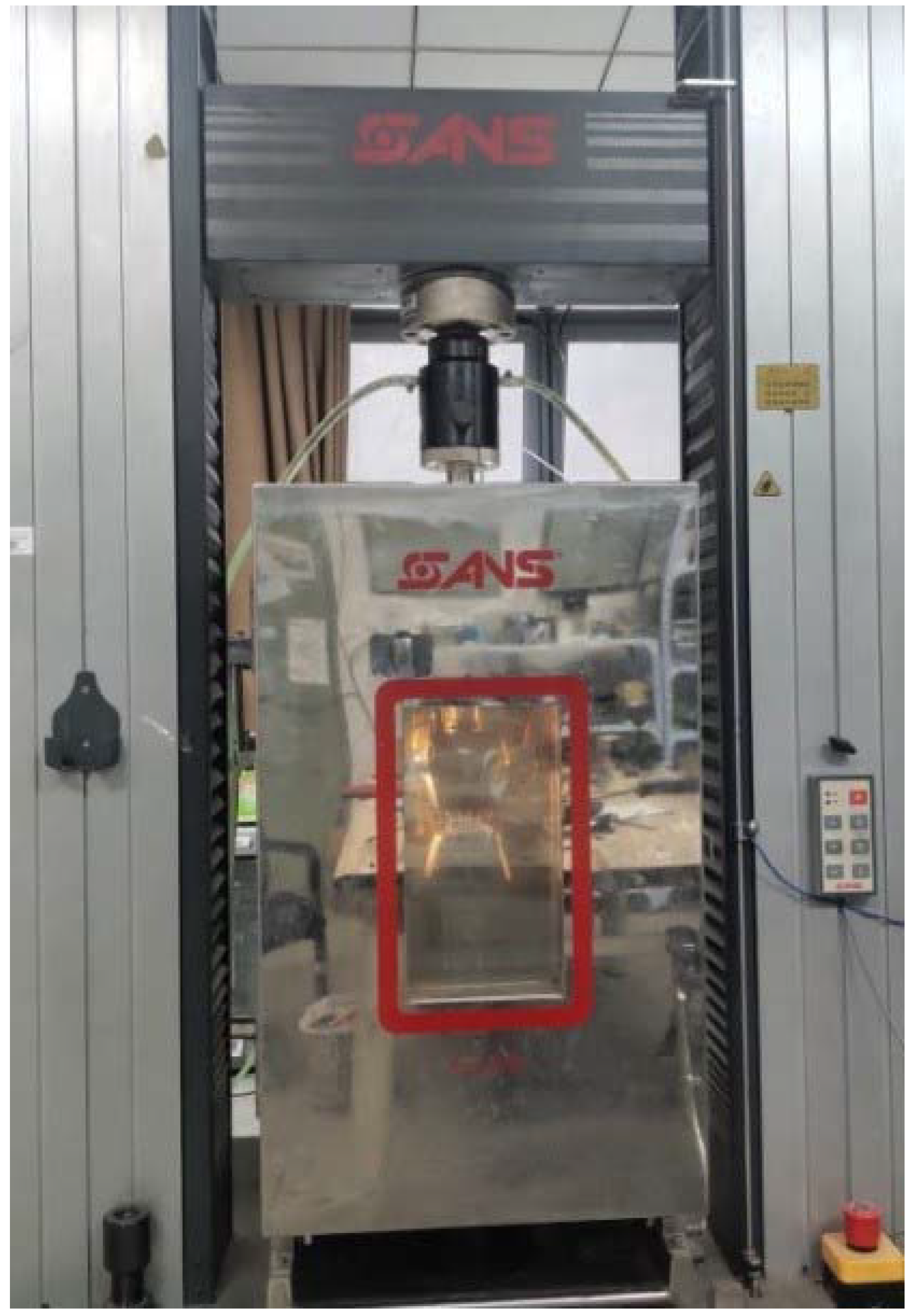
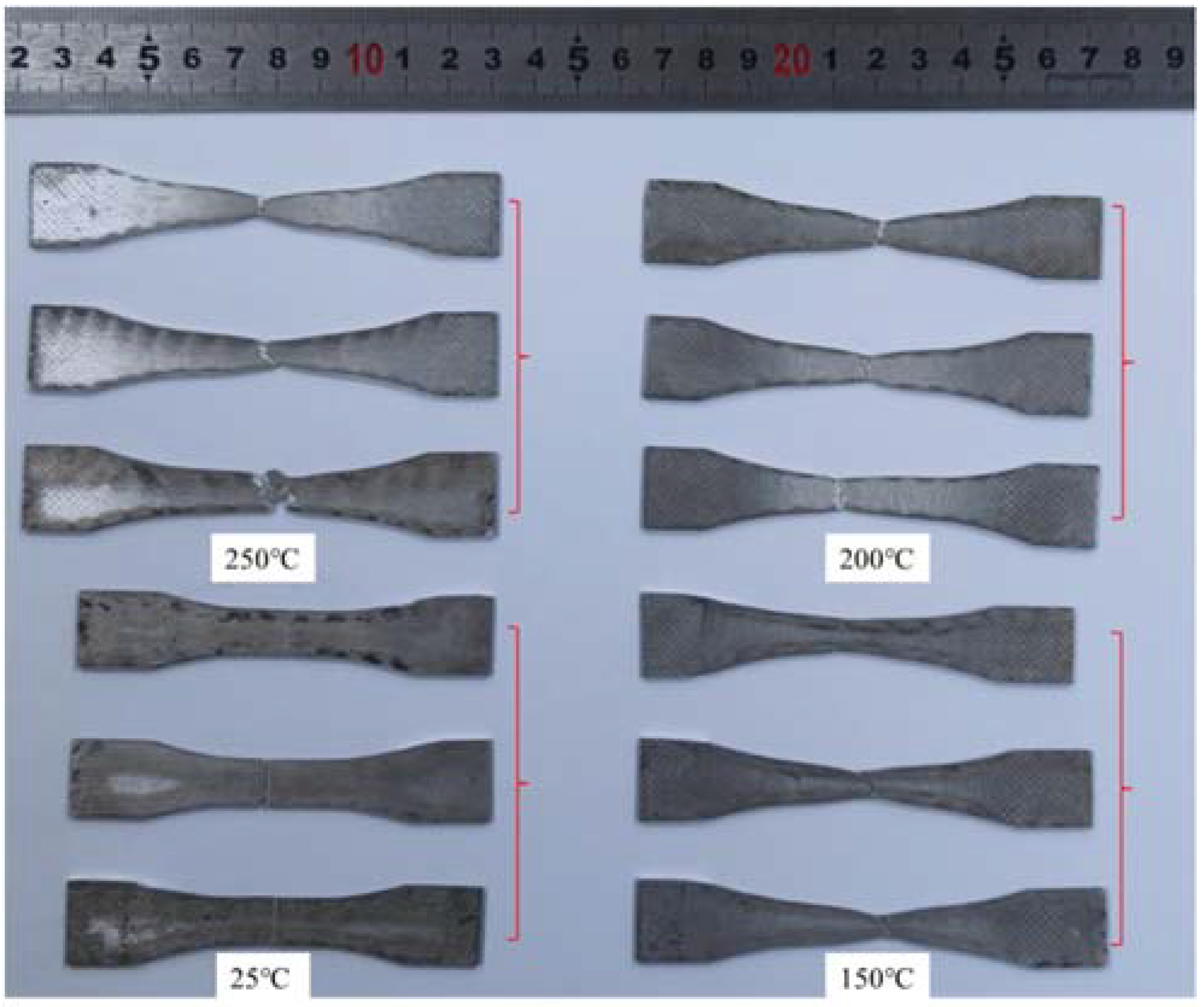
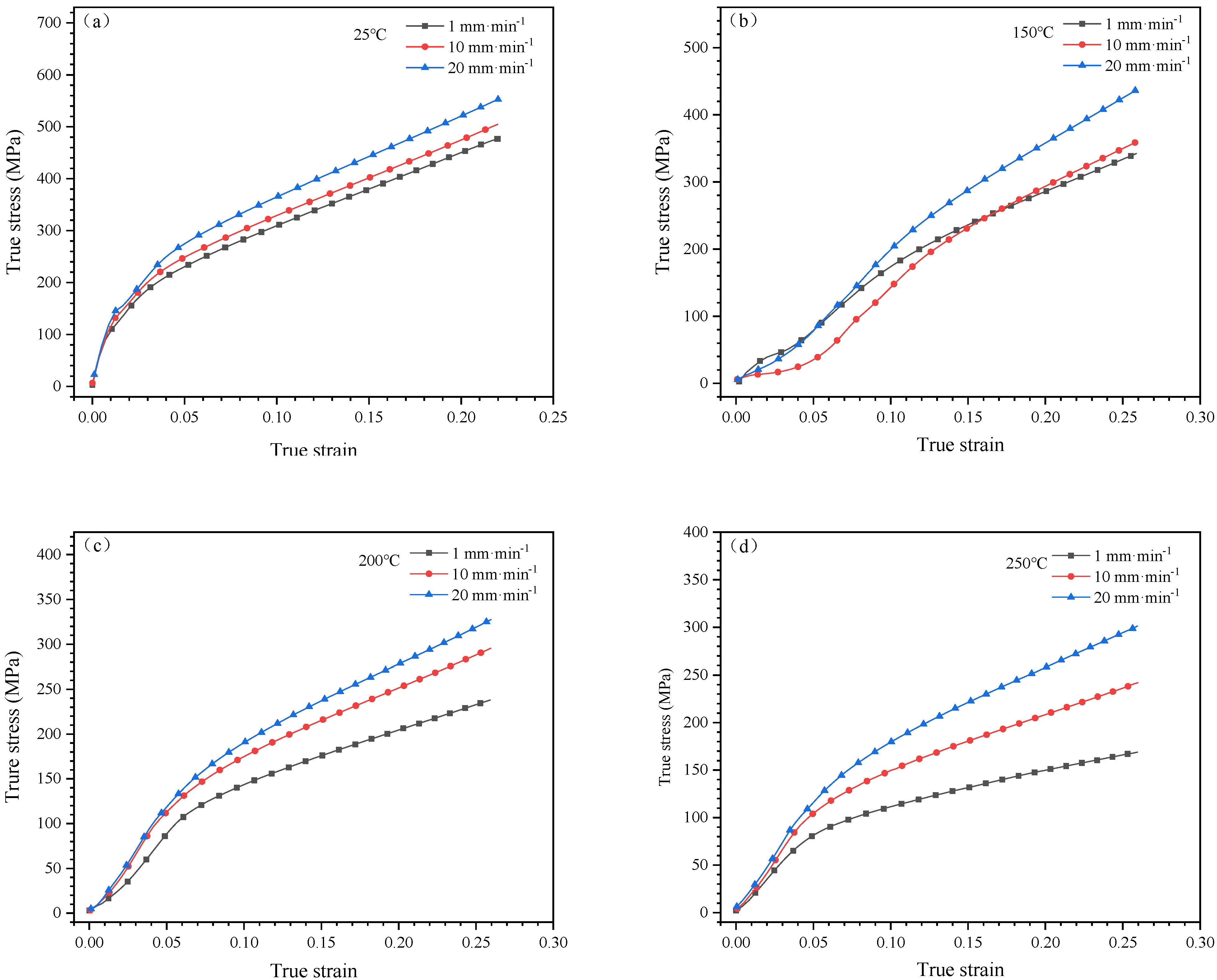
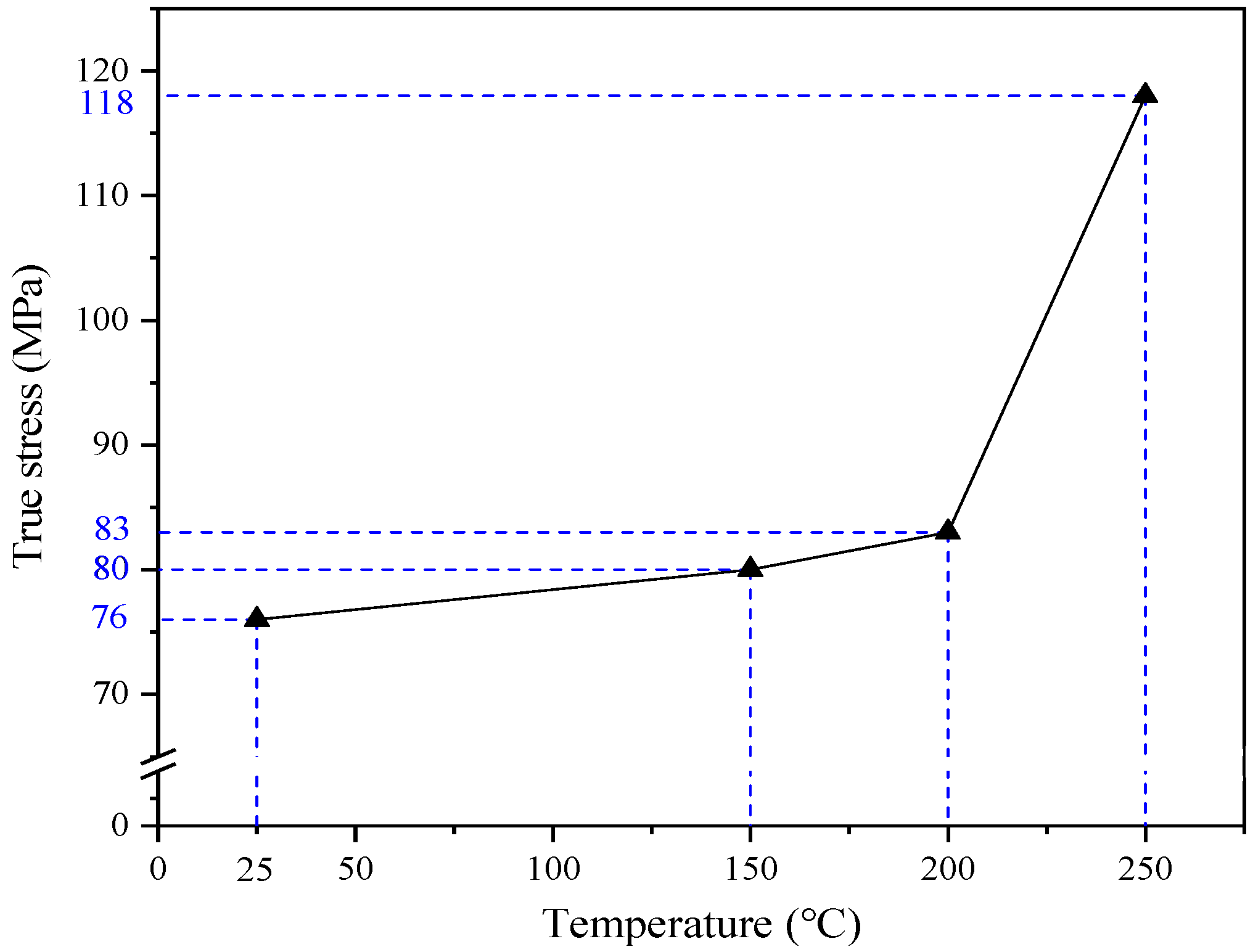

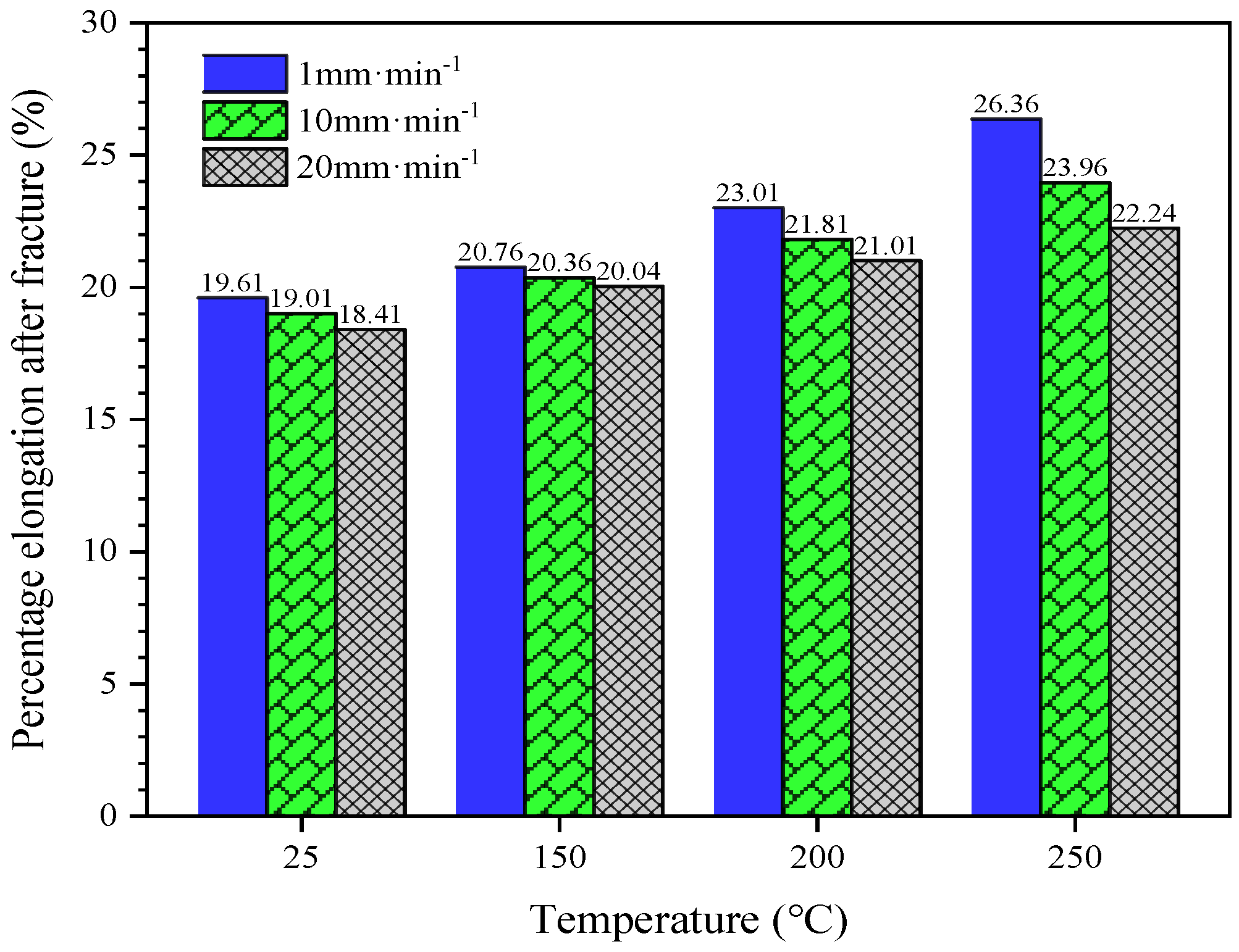
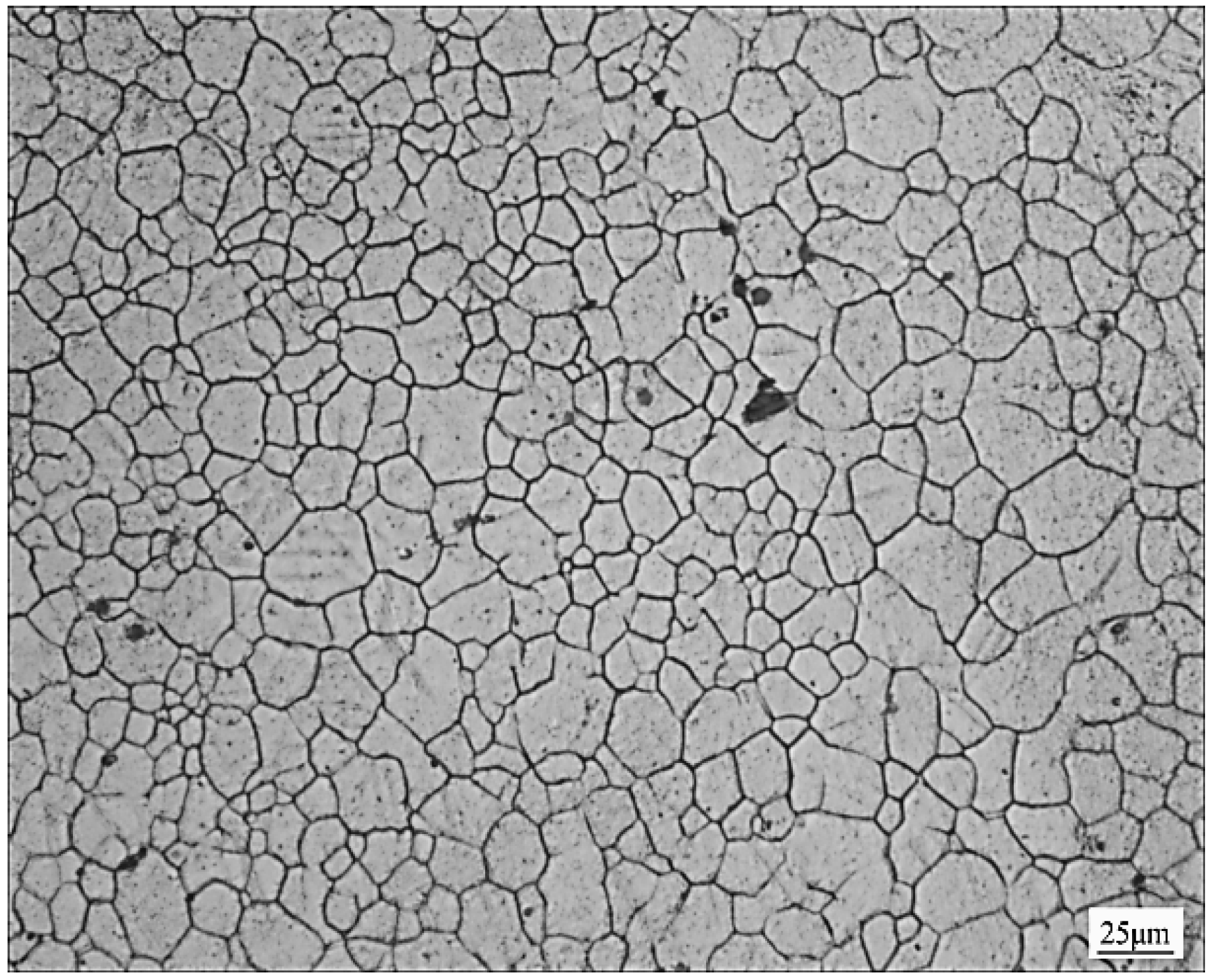
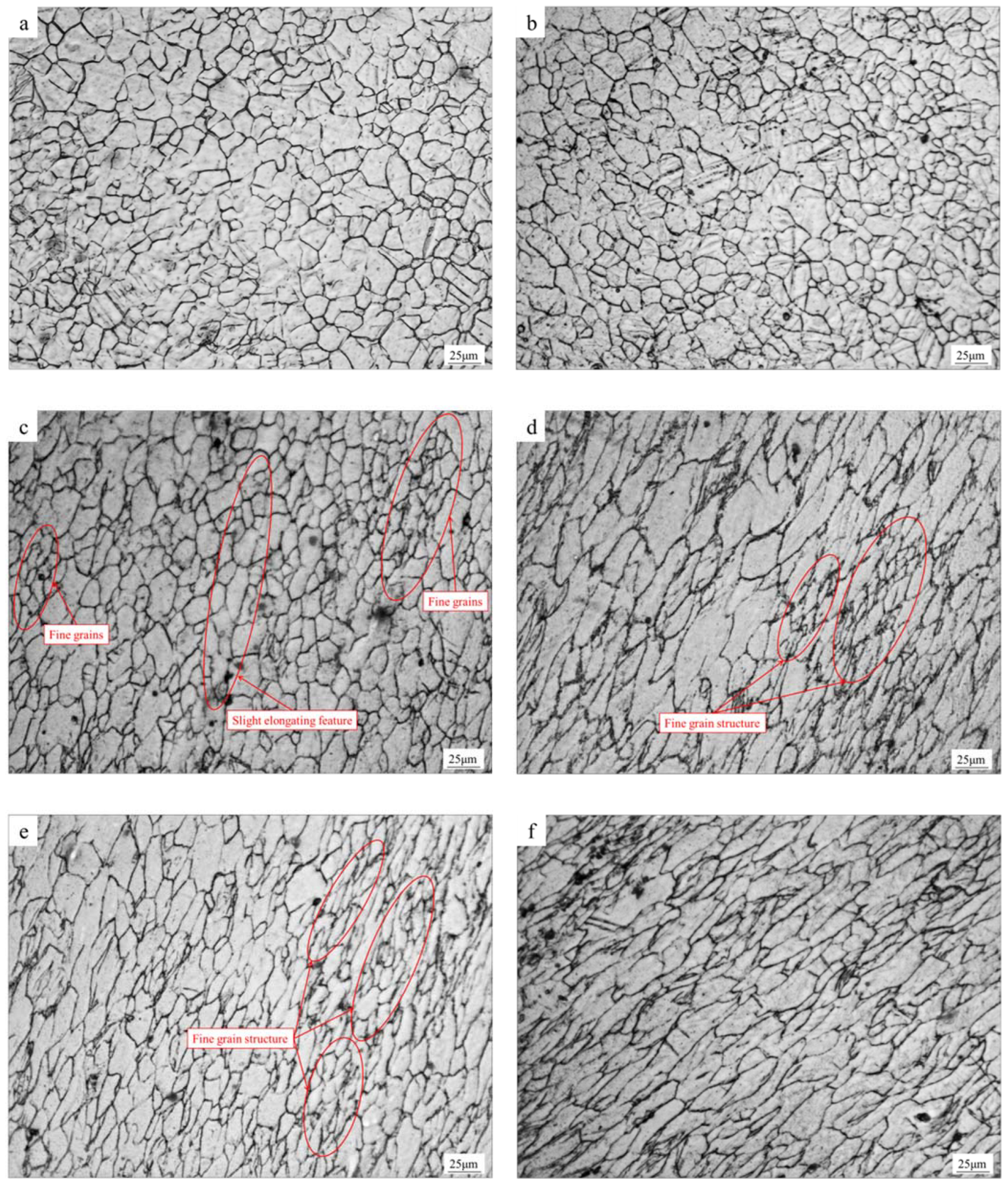
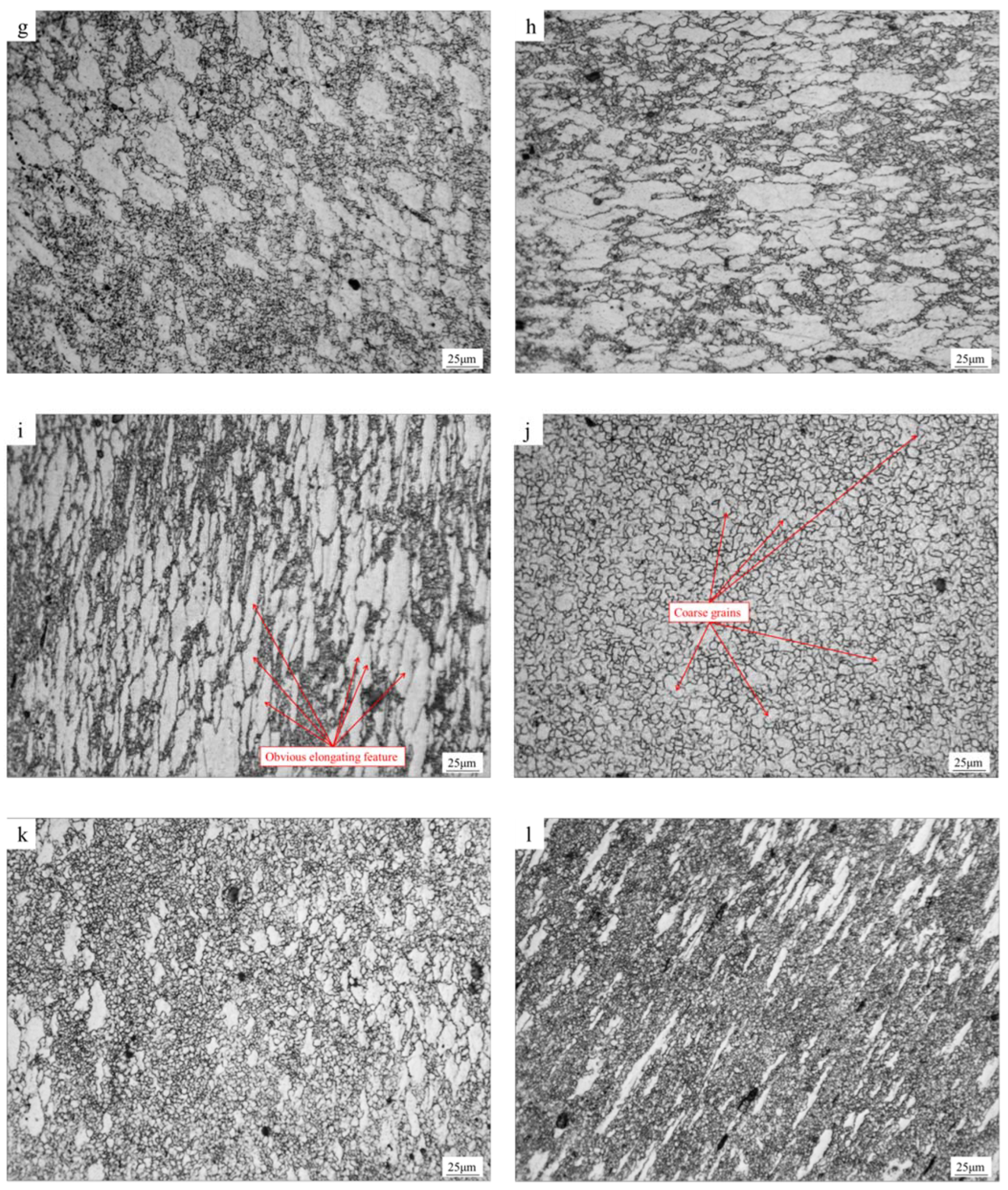
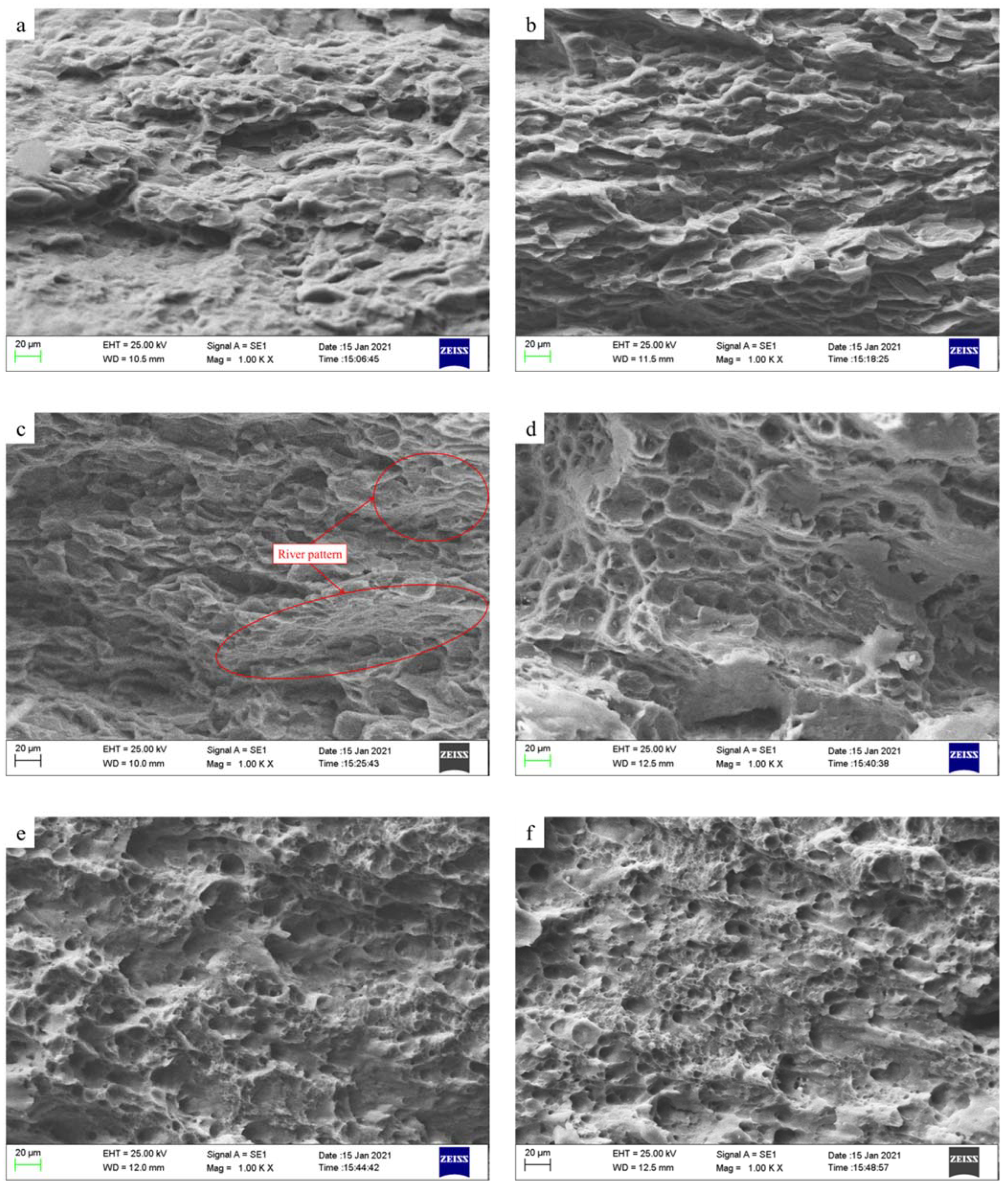
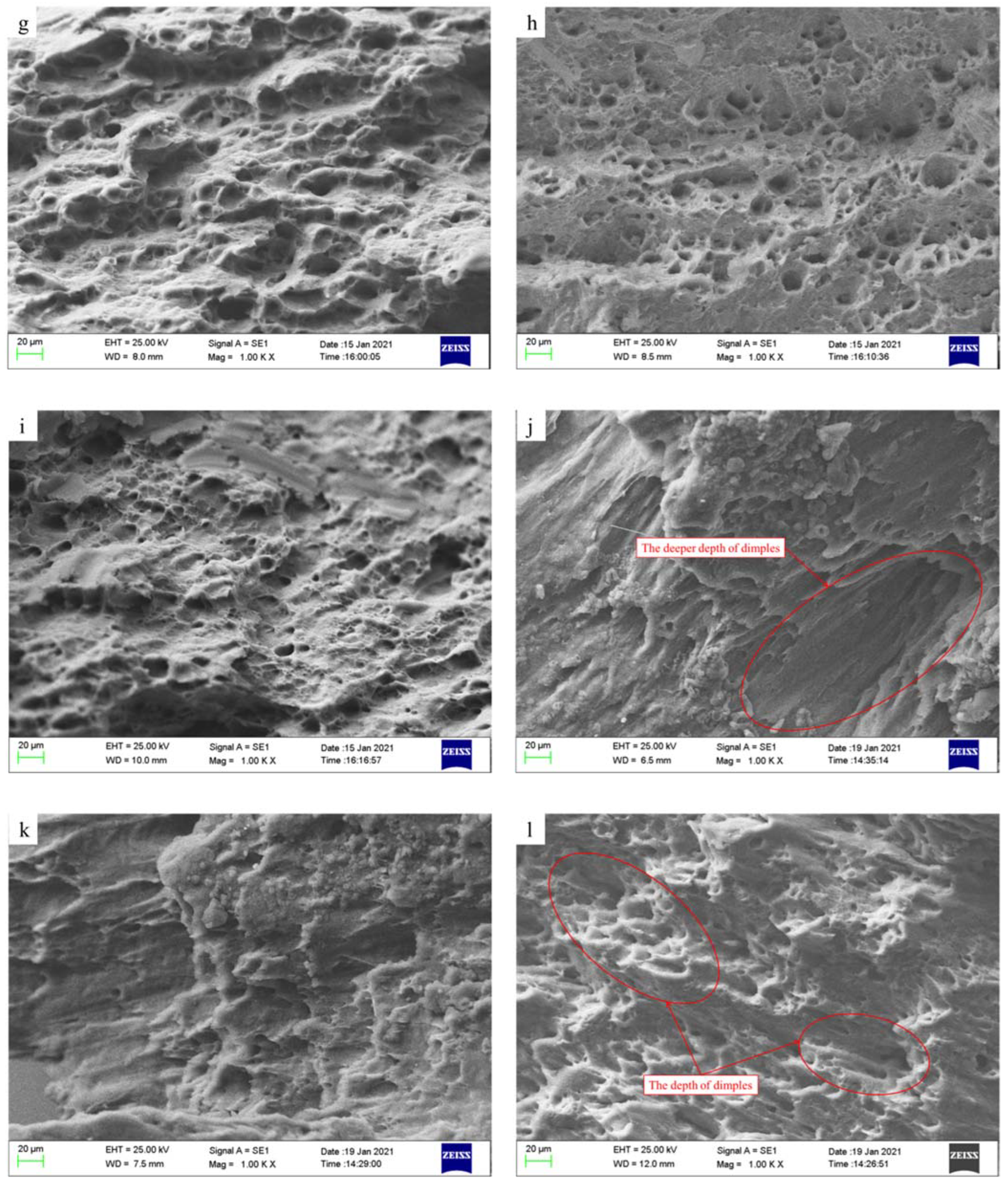
| Element | Mg | Al | Si | Ca | Zn | Mn | Fe | Cu | Ni |
|---|---|---|---|---|---|---|---|---|---|
| Standard value | bal. | 2.420 | 0.080 | 0.040 | 1.020 | 0.300 | 0.003 | 0.010 | 0.001 |
Publisher’s Note: MDPI stays neutral with regard to jurisdictional claims in published maps and institutional affiliations. |
© 2022 by the authors. Licensee MDPI, Basel, Switzerland. This article is an open access article distributed under the terms and conditions of the Creative Commons Attribution (CC BY) license (https://creativecommons.org/licenses/by/4.0/).
Share and Cite
Xue, S.; Yang, T.; Liu, X.; Ren, Y.; Peng, Y.; Zheng, L. Strain Rate and Temperature Effects on Formability and Microstructure of AZ31B Magnesium Alloy Sheet. Metals 2022, 12, 1103. https://doi.org/10.3390/met12071103
Xue S, Yang T, Liu X, Ren Y, Peng Y, Zheng L. Strain Rate and Temperature Effects on Formability and Microstructure of AZ31B Magnesium Alloy Sheet. Metals. 2022; 12(7):1103. https://doi.org/10.3390/met12071103
Chicago/Turabian StyleXue, Song, Tao Yang, Xuedong Liu, Yi Ren, Yi Peng, and Lixuan Zheng. 2022. "Strain Rate and Temperature Effects on Formability and Microstructure of AZ31B Magnesium Alloy Sheet" Metals 12, no. 7: 1103. https://doi.org/10.3390/met12071103
APA StyleXue, S., Yang, T., Liu, X., Ren, Y., Peng, Y., & Zheng, L. (2022). Strain Rate and Temperature Effects on Formability and Microstructure of AZ31B Magnesium Alloy Sheet. Metals, 12(7), 1103. https://doi.org/10.3390/met12071103






